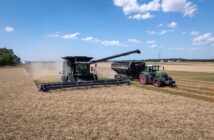GB wheat protein could be on track to be the highest on record, according to the first provisional results of AHDB Cereals & Oilseeds’ Cereal Quality Survey 2017. However, wet weather during harvest has affected Hagberg Falling Numbers (HFN).
Meanwhile, the provisional results for barley show that while specific weights and grain sizes are broadly in line with last season, higher nitrogen levels could prove challenging.
Wheat
For the 2,858 wheat samples analysed by 31 August, the provisional average protein level was a record for the first release at 13.2 per cent. This compares to the three-year average at this stage of 12.1 per cent.
James Webster, AHDB cereals & oilseeds analyst said: “We are seeing the highest ever average protein level for GB at this stage of the Cereal Quality Survey. However, protein content is a weak indicator of milling and baking quality. As such there will also be a number of questions asked about the functionality of the protein (gluten) this season.”
Hagberg Falling Numbers for all of the wheat sampled to date averaged 259s, some way below last season when HFNs averaged 319s at the same point in the survey. The provisional result this season is also lower than the provisional result for the 2012 harvest (267s). However, it is worth noting that the averages of the nabim Group 1 samples is above the level required to meet the requirements for full specification bread wheat (250s), at 260s
Mr Webster added: “We have seen a great deal of variation in Hagberg levels across the wheat crop, with samples ranging from 79s to 432s. However, because the samples so far are biased to the earlier-harvested regions, we could well see the average Hagberg level falling further. Later harvested regions were hit harder by summer rainfall which led to a challenging stop-start harvest for many.”
“The nature of the fractured 2017 harvest will also raise questions over the consistency of quality of the domestic wheat crop relative to imported supplies.”
Specific weights this season are broadly in line with the same stage last year. At 76.8kg/hl they are the lowest since 2012, but not far off last year’s first provisional average of 77.2kg/hl. Of the nabim Group 1 samples analysed to date, it looks like Crusoe has been most affected by the drop in HFNs, falling from 306s in last season’s provisional results to 247s in the 2017 first provisional estimates.
The first provisional results have a regional bias towards the East and South East, representing 36 per cent and 38 per cent respectively of the total sample. Furthermore, nabimGroup 1 varieties account for 62 per cent of the samples analysed to date. As we move toward the second provisional and final results, we will develop a much clearer picture of UK wheat quality, addressing the regional and varietal biases. This will give us further clarification as to the extent to which grain quality was affected by the rain during harvest.
Barley
The first provisional results indicate increased average nitrogen levels, which could prove challenging for some markets. This year has seen nitrogen levels rise, averaging 1.69 per cent of dry matter for samples to date across GB.
Mr Webster commented: “In Scotland where a large proportion of the suitable grain goes into malting we have seen average nitrogen levels of 1.59 per cent. As a general rule of thumb Scottish maltsters are looking for nitrogen levels under 1.65 per cent, but with nitrogen creeping up again this season it could lead to some barley not meeting specification.”
The results also indicate a higher specific weight and grain size than seen in last year’s provisional results, although this is still behind the three year average of final results.
The 8,545 barley samples analysed from across GB had an average specific weight of 64.7kg/hl, 1.1kg/hl greater than at the same stage last year.
Screenings have also shown marked improvement on the year, although not when compared to their respective three year averages.
The provisional screening data shows 2.7 per cent of grains passing through a 2.25mm sieve, compared with 4.4 per cent at this point last year. Furthermore, the proportion of grain retained by a 2.5mm sieve is also improved on the year at 91.1 per cent, compared with 88.5 per cent at the same stage last year.
One characteristic seen across both wheat and barley is crops being sampled at higher moisture levels.
Mr Webster added: “The average moisture level of the barley sampled was 15.5 per cent, which will result in a greater volume requiring further drying before the crop can be processed. In Scotland the average moisture level is higher still at 16.8 per cent. According to the Maltsters’ Association of Great Britain (MAGB) the current acceptable moisture level for barley contracts is 14.5 per cent. While allowances are made above this level it will result in deductions or possibly increased rejections of some samples.”
Of the barley samples analysed so far, 59 per cent have come from Scotland and the East.
These provisional results will be updated in early October and the final 2017 Cereal Quality Survey results will be published in late October/early November.
Further details on the AHDB Cereals & Oilseeds Cereal Quality Survey can be found at http://cereals.ahdb.org.uk/markets/survey-results.aspx




